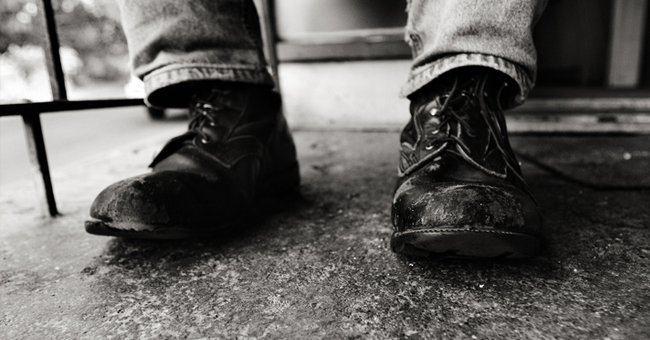It’s no secret that a physically demanding job requiring hours of movement on your feet can have pretty hellacious long-term results on your body. And, if you’ve ever gotten stuck pulling a long shift with the wrong shoes, you know it can also actually hurt. Proper footwear is so crucial to anyone working behind a bar; yet supportive shoes that hold up to slippery floors and long shifts can be surprisingly hard to find (particularly when you bring in other factors, like budget, personal aesthetics and any lingering desire for your footwear to not resemble something an orthopedic surgeon would prescribe).
“Bartenders and wait staff that stand for a living can suffer sore and swollen feet and legs, tired muscles, lower back pain and achy necks and shoulders,” says Dr. Eunice Ramsey-Parker, DPM, MPH, and Clinic Administrator of the Foot Center of New York. “Feet are particularly vulnerable to swelling, achiness, calluses, bunions, corns, pain in the arches, and varicose veins, among other effects.” But don’t despair just yet — with the right stretches, shoes, and maybe even socks, a lot of these issues can be mitigated or avoided entirely.
We asked a few podiatrists to weigh in with their recommendations for shoe-shopping, foot care, stretches and everything else you should know to keep your feet healthy and pain-free. (We also asked over a hundred bartenders to share their picks for shift-worthy shoes — stay tuned for that installment next week.) Read on for the scoop from medical experts:
Pre-shift steps: keep it clean (and dry)
“Before work, feet should be washed and thoroughly dried,” says Dr. Ramsey-Parker. “Fresh hosiery should be worn every day. Different shoes should be worn for commuting to work and on the job.”
When shoe-shopping, go for structure (and skip the ballet flats)
“I would recommend bartenders wearing shoes that give good arch support and foot/ ankle stability,” says Dr. Suzanne Fuchs, a podiatrist practicing at Luxe Podiatry in Palm Beach, Florida. “Standing on your feet all day, for most people, can cause increased pressure to your arch and heel. Wearing a shoe with built in support and or an orthotic insert can help. Also, wearing shoes that have a good structure and are not flimsy. You want to avoid shoes such as ballet flats or those that you can easily bend for all day wearing.”
New Jersey podiatric surgeon Dr. Dana Canuso echoes this: “When looking for any shoes that you’re going to be walking around in all night, make sure that they do not bend if you fold them in half,” she says. “They should be rather stiff and have a significant amount of arch support.” And, she adds, “under no circumstances should a bartender wear completely flat ‘ballet’ shoes. Even though flats seem like they would be the most logical choice for comfortable shoes to wear for a long time, they can actually cause pain in the arch and heels and hurt your lower back.”
Don’t forget to test-drive
“I always tell my patients, though the shoe may feel good in the store, it’s always a good idea to wear them around the house for a few hours to do a test run before wearing them to work,” says Dr. James Hanna, podiatrist in Lockport, NY and a spokesperson for the New York State Podiatric Medical Association (NYSPMA).
Ask your manager if mats are an option
To keep feet pain-free while standing on them, Dr. Hanna recommends asking your employer for an anti fatigue floor mat – a thick, rubber mat that provides extra cushion to complement the support of the shoe and could help you through a long night on your feet.
Consider doubling up on socks
“If a bartender is prone to blisters, wear two pairs of socks to create an extra layer of protection,” says Dr. Hanna. “This will help cut down on the friction of the shoe.”
Always keep feet dry and shoes clean
“Feet that are perspiring in shoes all night are susceptible to warts, athlete’s foot, foot odor and other conditions,” says Dr. Hanna. “If possible, have two pairs of shoes that can be rotated and aired out between shifts. Also, spray shoes with Lysol to help stop the spreading of bacteria and germs.”
Look into accessories
“Gel insoles can help alleviate a lot of discomfort, but if the wearer has arch or heel pain or posture problems, a podiatrist must be consulted,” says Dr. Ramsey-Parker. “The doctor will prescribe custom orthotics that will keep the wearer’s feet, legs and back in good alignment at work and should relieve a lot of pain.”
Consider upgrading your socks
“Support or compression hose can make a huge difference if feet and legs are swelling, tired or achy,” says Dr. Ramsey-Parker. “Support or compression socks are available for men, and support or compression hose of different types are available for women. No matter what kind of hosiery is worn, make sure the feet can breathe and that the hose fabric wicks moisture away.”
And if you must wear heels…
Heels can be a pain for anyone, especially those who actually have to be on their feet constantly while wearing them. But for bartenders working within the confines of a dress code (or who just need a little extra height), there are ways to wear heels without destroying your feet and legs. “By far, the best combination of style and comfort is a platform wedge with around a 2 to 3 inch heel,” says Dr. Canuso. “A platform heel is always going to be more comfortable and you can subtract the platform height from the heel height. So if you have a shoe with a half inch platform, you can go up to a 3 inch heel.”
Post-shift: treat yourself
“For after-work care, and preventive care: warm foot soaks after work are nice, though not for diabetics,” says Dr. Ramsey-Parker. “Self foot massages also feel good. On breaks or at home, stretches can help relieve discomfort in the calf, back of the foot and heel.” She also adds that regularly doing a heel stretch can help, and recommends the stretches found here.
Stay tuned for next week’s follow-up, where we’ll feature the most popular work shoes from our survey of over one hundred working bartenders.





